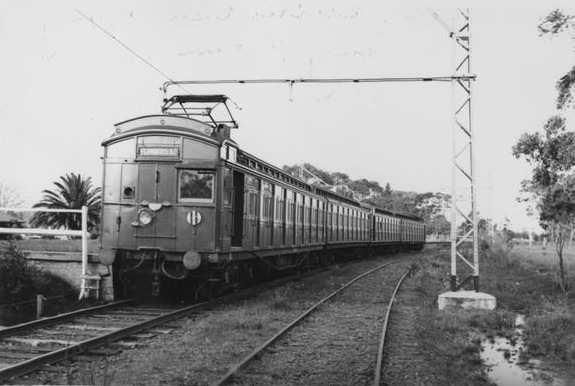- Tait (train)
Infobox EMU
background =
name = Tait

imagesize = 300px
caption = Four car Tait train at the Spring Vale Cemetery platform
interior
interiorcaption =
InService =Manufacturer =
Victorian Railways
factory =Newport Workshops
Family =
Built =
Refurbishment =
replaced = Steam hauled carriages
yearconstruction = 1915-1953
yearservice = 1919 (as EMU cars)
yearscrapped = last in 1984
numberconstruction =
numberbuilt =
numberservice =
numberscrapped =
Formation =
designation = 201-461M (motor cars),
470-473M (double ended motor cars)
201-265D (driving trailers),
201-372T & 380-442T (trailer cars)
1-103G (dual lighting trailers)
Operator =Victorian Railways
Depots =
LinesServed = All Melbourne SuburbanCarBody =
CarLength =
CarWidth =
CarHeight =
floorheight =
platformheight =
entrylevelorstep =
art-sections = NoneMaxSpeed = 83km/h
Weight =
Capacity =
Acceleration =
Deceleration =
Traction = 4 x 105 kW GE239
Power =
Gauge =
Voltage = 1500V DC overhead
Brakes =
SafetySystem =The Tait trains, also referred to as the "Red Rattlers", were a wooden bodied
Electric Multiple Unit train that operated on the suburban railway network ofMelbourne , Victoria,Australia . They were introduced in 1910 by theVictorian Railways as steam locomotive hauled cars, and converted to electric traction in from 1919 when the Melbourne electrification project was underway. [http://www.pjv101.net/cd/pages/c225m.htm Peter J. Vincent: M - Sliding Door Suburban Motor Car] ] The trains derived their name from Sir Thomas James Tait, the chairman of commissioners of the Victorian Railways from 1903 to 1910. [ [http://www.adb.online.anu.edu.au/biogs/A120180b.htm Australian Dictionary of Biography, Online Edition: Tait, Sir Thomas James (1864 - 1940)] ] The first cars were built during 1909 with the last entering service in 1951. [http://www.pjv101.net/cd/pages/c020m.htm Peter J. Vincent: T - Sliding Door Suburban Trailer] ]The trains were initially known as "Sliding Door" trains, as opposed to the Swing Door then in service. They were later known as "Red rattlers" or "Reds" from the 1950s when the blue painted Harris trains were introduced.
Layout
Tait trains have a partly open saloon layout, with bench seats running across the train, the saloon being divided by partitions into a number of smaller areas. Each seating aisle is provided with its own exterior sliding door.
Incandescent lighting, a ceiling with pressed tin patterns, luggage racks above head height, and stained woodgrain walls were fitted inside each compartment. Interiors were split into smoking and no-smoking compartments until late 1978 with the abolition of smoking on trains, and carriages were designated as First or Second class until 1958 when one class travel was introduced.
The exterior of the trains are of two main styles: clerestory roofed, and the later arched roof from the late 1920s onward.
From 1971 the interior was simplified to cut maintenance costs, with some doorway windows being replaced by metal and plywood, and sun blinds being removed.S.E. Dornan and R.G. Henderson: (1979) "The Electric Railways of Victoria'] The motor
bogie s on the trains were originally of pressed steel construction, being changed for a new design in cast steel in the 1930s.Equipment
General Electric traction equipment was fitted to the trains, of the same at that of in the Swing Door trains and enabling the trains to be operated in multiple.et configuration
A number of carriage types were built - 'M' driving motor cars, 'T' trailer cars, 'D' driving trailer cars, and 'G' trailer cars fitted with gas lighting for locomotive hauled country use. [ [http://www.pjv101.net/cd/pages/tyessld.htm Peter J. Vincent: Sliding Door (Tait) cars] ] Trains usually operated as a M-T-T-M+G-T-M setup. [http://www.pjv101.net/cd/pages/c124m.htm Peter J. Vincent: G - Suburban/Excursion Car] ]
The 'D' type cars were the least common of the car types: of the 66 cars built with guards compartments, only 18 were fitted with control equipment and coded 'D' in 1923. The rest were known as 'ringer' trailers, having a white ring on the door indicating the compartment was available for the use of passengers. It was not until 1964-72 the numbers increased to over 60 with the 'ringers' being converted to 'D' cars as intended.
Five Tait motor carriages were converted to parcel vans: 1CM to 5CM. Six further parcel vans were converted from Swing Door trains. [ [http://www.pjv101.net/cd/pages/c106m.htm Peter J. Vincent: M - CM - Suburban Parcels Coach] ]
The Tait trains originally entered service as six car sets, the majority made up of three 'M' cars and three trailers. From the 1920s sets were extended to 7 cars sets, with the introduction of the 'G' trailer cars. These sets were made up of a four car 'block' and a three car 'unit'.
Regular two car operation of Tait trains commenced in 1964, with a 'block' of cars made up M-D-M-D that could be split as required. One car operation commenced in 1968, after the conversion of 470M the previous year and the end of union disputes.
In May 1968 a 8 car Tait train was tested on the Frankston line, made up of 3 motor cars and 5 trailers, entering service under the new timetable in August 1968. After 1973 these 8 car sets were reconfigured with a 50:50 motor - trailer mix to avoid special rosters restricting 3 motor car sets to flatter lines.
From 1973 3 car sets were also reintroduced, as M-T-D consists. Six car M-T-T-T-T-M consists were also formed for peak hour use.
Retirement
The Tait trains were replaced from 1974 by the Hitachi trains sets, and the later Comeng trains.
From 1981 the last 37 of them were being replaced by 50 Comeng trains. They were not allowed in the
City Loop due to fire hazard presented by their wooden bodies, so they spent most of their final years on the Port Melbourne, St Kilda and Sandringham lines.Due to industrial problems the last Tait trains were withdrawn from service in 1984.
References
External links
* [http://www.pjv101.net/cd/pages/tyessld.htm Peter J. Vincent: Sliding Door (Tait) cars]
* [http://vicsig.net/index.php?page=suburban&traintype=Tait Vicsig.net Tait Trains]
Wikimedia Foundation. 2010.
